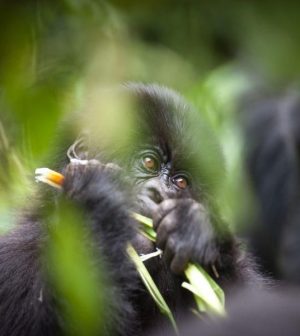- Navigating Your Midlife Crisis: Embracing New Possibilities
- City Raccoons Showing Signs of Domestication
- Mapping the Exposome: Science Broadens Focus to Environmental Disease Triggers
- One Week Less on Social Media Linked to Better Mental Health
- Your Brain Changes in Stages as You Age, Study Finds
- Some Suicide Victims Show No Typical Warning Signs, Study Finds
- ByHeart Formula Faces Lawsuits After Babies Sickened With Botulism
- Switch to Vegan Diet Could Cut Your Greenhouse Gas Emissions in Half
- Regular Bedtime Does Wonders for Blood Pressure
- Dining Alone Could Mean Worse Nutrition for Seniors
Maskless Tourists Could Pass COVID-19 to Wild Gorillas

Seeing mountain gorillas in the wild might be the moment of a lifetime that you want to capture with a selfie, but think twice before removing your face mask for the shot.
While everyone knows mask-wearing curbs the spread of COVID-19 among humans, wearing masks might also help prevent transmission to other primates.
But scientists from Oxford Brookes University in England say that was not happening in nearly 1,000 Instagram posts shared by tourists of their trips to see mountain gorillas in Africa. In the photos, tourists were typically close enough to the animals — without face masks — to make transmission of viruses and diseases possible.
“The risk of disease transmission between visitors and gorillas is very concerning,” said study author Gaspard Van Hamme, an Oxford Brookes University Primate Conservation alumnus.
“It is vital that we strengthen and enforce tour regulations to ensure gorilla trekking practices do not further threaten these already imperiled great apes,” he said in a university news release.
Researchers are already aware of the potential for coronavirus infection in gorillas. In January, captive gorillas at San Diego Zoo tested positive for SARS-CoV-2, the virus that causes COVID-19.
“In the photos we analyzed, we found that face masks were rarely worn by tourists visiting gorillas and that brings potential for disease transmission between people and the gorillas they visit,” said Magdalena Svensson, a lecturer in biological anthropology. “With people all over the world getting more used to wearing face masks we have hope that in the future wearing face masks will become common practice in gorilla trekking.”
The findings were published Feb. 16 in the journal People and Nature.
Mountain gorillas can be found in the Democratic Republic of Congo (Virunga National Park), Uganda (Bwindi Impenetrable National Park and Mgahinga Gorilla National Park), and Rwanda (Volcanoes National Park). In recent decades, these populations have suffered from the ill effects of human activities, yet in more recent years gorilla numbers have been increasing. It is now estimated that there are 1,063 mountain gorillas.
Trekking is an important financial support to mountain gorilla conservation, but large visitor numbers can impact wildlife and the environment. Guidelines require visitors and gorillas stay 7 meters — which is almost 23 feet — apart, but they are not adequately followed or enforced, according to the study.
“This research provides a valuable perspective on how much tourists are willing to share their too-close encounters with mountain gorillas through Instagram, which creates expectations for future tourists,” said Dr. Gladys Kalema-Zikusoka, veterinarian and CEO of Conservation Through Public Health in Uganda. “It highlights a great need for responsible tourism to provide adequate protection while minimizing disease transmission, especially now during the COVID-19 pandemic.”
More information
National Geographic has more about mountain gorillas.
SOURCE: Oxford Brookes University, news release, Feb. 16, 2021
Source: HealthDay
Copyright © 2025 HealthDay. All rights reserved.










